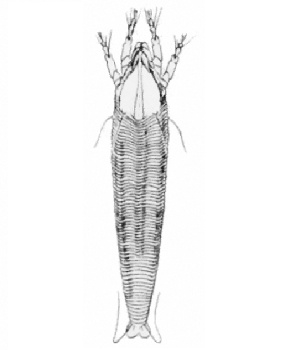Cereal rust mite facts for kids
Quick facts for kids Cereal rust mite |
|
|---|---|
 |
|
| Abacarus hystrix (Cereal rust mite) |
|
| Scientific classification | |
| Genus: |
Abacarus
|
| Species: |
hystrix
|
The cereal rust mite, also known as the grain rust mite, is a tiny creature that belongs to a family of mites called Eriophyidae. These mites are super small, usually less than 1 millimeter long, and they only have four legs at the front of their bodies. You would need a special magnifying glass (10-20 times zoom) to see them! Cereal rust mites are often yellow, but they can also be white or orange.
They were first found on a common grass called couch grass. Now, they live on over 60 different types of grasses, including important crops like oats, barley, wheat, and ryegrass. You can find them in many parts of the world, like Europe, North America, South Africa, and Australia. These mites mostly travel by wind. They are usually found on the highest parts of the top two leaves of a plant. Cereal rust mites can breed very quickly, having up to twenty new groups of mites each year in some places. They can cause a lot of damage to crops, sometimes reducing the amount of grain harvested by a large amount.
Life Cycle of the Cereal Rust Mite
Cereal rust mite eggs are extremely tiny. The female mites place them in the grooves of plant leaves. These eggs usually start to hatch in early spring. This is around March in the Northern Hemisphere and September in the Southern Hemisphere.
Once the eggs hatch, the young mites grow up very quickly. They reach their adult stage in about 16 to 18 days. When they become adults, they often move to the lower parts of the plant. There, they feed on the newer, softer plant tissues. These mites are present throughout the plant's entire growing season. However, they become less active when temperatures get warmer. This is because cereal rust mites prefer cooler weather, unlike some other types of mites.
How Mites Harm Grasses
The cereal rust mite, Abacarus hystrix, can cause problems for grasses in two main ways. First, it can carry and spread two different viruses. These viruses are called Agropyron mosaic and Ryegrass mosaic. The Ryegrass Mosaic Virus (RMV) is only spread by this specific mite. When a plant gets RMV, you might see yellow streaks on its leaves.
Second, the mites cause direct damage to the leaves when they feed. They prefer to feed on the smooth, larger cells found at the bottom of leaf grooves. When the mites feed, they damage the leaf cells. This damage can make the leaves change color. They might look discolored or have a "rusty" appearance.
Managing Cereal Rust Mites
It is a good idea to check fields regularly for mites, especially before spring arrives. Farmers can use a method called a quadrat system. This means they pick random plants from different spots in the field to check. When checking, you should look for eggs and young mites. They are usually found in the grooves of the leaf veins.
One way to help manage these mites is to keep the grass shorter during cooler months. Studies have shown that trimming grasses can reduce the number of mites. Since these mites can spread viruses, having fewer mites means the viruses spread less quickly. This helps to protect the health of the grasses and crops.

